365 days of ‘brat’: the neon green, electropop cultural phenomenon
Henry Redcliffe
Now, twelve months later, brat is more of a Gen Z cultural timestamp than anyone could have anticipated. It captured a very specific post-pandemic energy; reckless, reflective, oversharing, overstimulated, and gave it a sound, a look, and a name. It made space for emotional contradictions. For dancing and crying at the same time. For being a little sleazy, but on purpose.
It’s hard to overstate just how massive brat was in online culture last summer, and even harder to pin down exactly why.
There are a few possible reasons.
Maybe it’s the deliberate carelessness that defines the album, its refusal to play by the usual rules of pop polish, that taps into today’s craving for postmodern irony. Or maybe its loud, chaotic maximalism, so unrefined it circles back around to being cool, is the aesthetic itself.
Henry Redcliffe
On the surface, ‘brat’ was a sweaty, strobe-lit dance album. It pulsed with the energy of warehouse parties, group chats, and neon green gracing articles of clothing.
But underneath the club beats and icy synths was something more vulnerable - almost uncomfortably so.
Charli’s fierce emotional clarity struck GenZ like a knife.
Brat covers difficult themes like motherhood, yearning, generational trauma, the confusing nature around female relationships, death, jealousy, and more. These themes mixed with the electropop and synths make you feel more.
Post pandemic, GenZ was hit hard emotionally and socially.
The young adults who missed out on experiences that form your late teen years yearned for something that gave accessible community. Brat brought that community that let you be messy, let loose, and not give a fuck about what others thought.
Brat also wasn’t designed to please. It wasn’t clean, or safe, or PR-sanitized.
And that’s exactly why it worked.
In a landscape where pop is often filtered and formulaic, Charli made something jagged, personal, and weird. And people were starving for it.
In a world of AI-generated perfection and over-strategized pop personas, brat is refreshingly human.
In the year since its release, brat has become a blueprint. We’ve seen other pop stars loosen up, get more raw, more dancey, more chaotic—in ways that feel directly influenced by Charli’s approach.
She proved you could be both niche and mainstream, both club rat and introspective poet.
And the fans? They didn’t just listen. They participated.
Henry Redcliffe
The community around brat became part of the experience. The memes. The edits. The essays. The fan-run raves.
It wasn’t just music, it was an ongoing conversation. (Not to mention the political impact and endorsement, with Charli tweeting “Kamala [Harris] IS brat”.)
A year later, we now have a full remix album full of other talented music stars, and a tour with both Charli xcx and Troye Sivan as headliners.
Brat allowed people to be unashamedly messy, directly challenging today’s political climate and social trends.
Brat is now one year old, and still the life of the party. And the afterparty. And the group chat about the afterparty.
Written by Shaughnessy Hoefer



